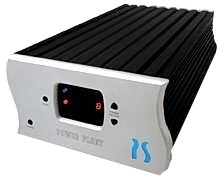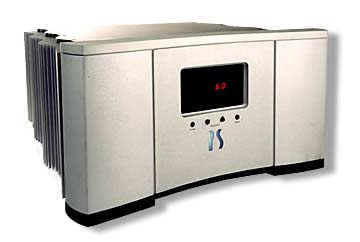This article is about PS Audio Power Plants in particular and power regenerators in general.
The first principle to make clear is that a regenerator is fundamentally different from a filter. Filters attempt to condition the mains waveform in order to clear it of noise and hash. They can do nothing to repair a distorted waveform. They also tend to introduce some worsening of impedance into the mains supply to the equipment, sapping its dynamics and slam to a degree.
Balanced transformers are another idea, mainly introduced into a system to rid the mains of any residual DC which can impair the funtionality of component power supplies by isolating the output from the utility supply. They frequenty incorporate some filtering too.
A regenerator uses reconstruction techniques to either fully construct a mains waveform from scratch, or actively repair it 'on the fly' in order to produce a perfect sinewave. In discussing regenerators we need to use examples from the PS Audio range over the years since they single-handedly introduced the concept of regeneration for hi-fi systems into the marketplace. This is as distinct from UPS battery backup systems for computers which usually generate a nasty dirty squarewave for powering the machine. Regenerators can also (but not all models) actively reduce the impedance powering the system as compared with the wall socket, enhancing system dynamics and potentially further lowering the noise floor.
First Generation
The first generation of devices, the P300, P600 and P1200, converted the incoming mains to DC by rectification and storage. They then used essentially a monster power amplifier to generate a pure 120VAC* waveform generated by a crystal clocking circuit and DAC to create the sinewave. A choice of output frequencies from 50 to 110Hz was selectable. They ran hot - very hot - due to their inefficient class AB design and they had limited power capability. In fact, only the giant P1200 had any chance of powering an entire system from clean mains and would have heated the room unbearably on summer days. The P300 could only supply source components and a preamp and you could almost cook eggs on the top plate after some hours of use.
*European versions added a 120-220VAC step-up transformer to generate the output voltages required. Not ideal, and it added to their heat output and weight.
Two mods came along during these products' lifetimes: a better DAC ROM board defining the waveforms more precisely, and Multiwave. This latter invention added small amounts of harmonics to the chosen output frequency, rounding their peaks and providing more charge to equipment power supplies during a complete cycle.
The small P300 certainly demonstrated to many enthusiasts a cost effective way in which, at last, their source components and preamps could be driven from a pure, noise-free power supply. The benefits were clearly audible in a lowered noise floor, better dynamics and finely resolved soundstage. My experience with the P300, having tried all modes, was that the 60Hz Multiwave option provided the best drive and the best resultant sound quality.

Second Generation
The second generation product was the Power Plant Premier and it entailed a complete re-think of how to go about generating a pure mains waveform. Instead of generating the waveform from scratch, this clever device 'rode' the incoming mains waveform with a small, efficient, amplifier and repaired the waveform by adding or subtracting current, compared with the ideal sinewave, to provide a corrected output waveform. The objective was to achieve much higher efficiency, higher power output and cooler running. With either 1kW or 1.5kW output capability, depending on which specs you believed, it succeeded in being the first regenerator capable of comfortably and efficiently powering an entire system. Frequency selection was gone (since the mains waveform was reconstructed), but Multiwave was still selectable in order to increase the charge time into component power supplies per cycle.
For the first time, the benefits of operating an entire system from regenerated mains, including the power amplifier, became clearly demonstrable. All the benefits of the P300 were manifested, only more so, with an especially low noise floor and black silences, as well as low output impedance and increased dynamic range.
The PPP also introduced Cleanwave, whereby a special degaussing waveform could be generated for 5s or 60s in order to degauss all the equipment connected to it. It's certainly controversial, but in my experience it gives a useful further 'cleaning' function if used before every listening session.
Unfortunately, PS Audio made the decision to move manufacturing of the PPP to China. It was not a happy move and reliability dramatically suffered with many reported failures of these later units. For the next generation, they decided to bring manufacturing back into the USA and suffer the necessarily higher factory costs that that would entail.
Third Generation
The third, and current, generation of regenerators build upon the excellent operating principles of the PPP with two models designed to provide 1kW and 1.2kW output respectively. The smaller P5 incorporates active (fan) cooling, while the larger P10 operates silently through passive cooling in the form of large heatsinks. The P10 also has twice the energy storage of the P5.
The key improvement in these devices is the increased storage (magnetics in PS AUdio parlance) and ability to respond to instantaneous fluctuations in demand, leading to very low output impedance (one hundredth that of the PPP) and improved dynamic power. They are also designed to be more resilient, the P10 for European markets capable of handling up to 280VAC input swings.
Finally, the P5 and P10 are more intelligent and use colour touch operating screens. They feature phased power-up of the components of a hi-fi system (e.g. the power amp can be fired up last), and can be connected to a network for remote control power up or power down over the internet and e-mailed power alerts.

Regenerator Characteristics
So what does a regenerator do for a system and why should you use one? The most obvious and most easily audible difference is the total lack of noise and interference. No mains-borne interference, no clicks and pops intruding into the music. Secondly is the apparent lowering of the noise floor when playing music, this by operating the components' power supplies without the distortion and overlaid DC that causes transformer vibration, intermodulation or other interference artifacts. Thirdly is the effect of rapid response to power demands and very low output impedance. This manifests as a level of dynamic swing and effortlessness that transforms a system from capable to outstanding and distinctly improves transparency and clarity. The sense of increased headroom, widened soundstage and purity of reproduction is very rewarding.
In my view, a regenerator is as important, if not more so, as any of the components of a qood quality hi-fi system. I would go so far as to say that above a given price level a regenerator is an absolute must since any further expenditure will not give as good a return in sound quality for the cost. All users of regenerators that I have spoken to would never be without one again.










 Reply With Quote
Reply With Quote
 Originally Posted by MartinT
Originally Posted by MartinT







